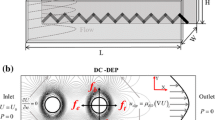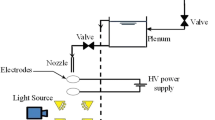Abstract
Electrical manipulation technique to produce qualified size of droplets has received substantial attention due to its wide applications in biology, medicine and chemistry, where the droplet behaviors could be controlled by adjusting external parameters. Characterization of charged droplet generation and breakup processes is crucial for understanding the basic mechanism of droplet manipulation. In this paper, the formation and breakup processes for charged droplets in dielectric immiscible oil were investigated experimentally at micro-scale by utilizing high-speed photography. The droplet behaviors at the ambient of needle orifice were visualized and captured at various electric field strengths and flow rates while its generation and motion characteristics were analyzed. Novel formation process of micro-droplets emitted from arrayed jets was found and depicted in detail when violent liquid breakup occurred at high voltage. Furthermore, the relationships of electric field and flow rate with characteristics of charged droplet behavior were quantitatively discussed. By consideration of electric field and flow rate, a scaling law to predict droplet size distributions was derived. Besides, a dimensionless model to predict charged droplet positions was given, which showed a linear increasing trend with electric field and time.
Graphic abstract














Similar content being viewed by others
References
Agostinho LLF, Bos B, Kamau A, Brouwer SP, Fuchs EC, Marijnissen JCM (2018) Simple-jet mode electrosprays with water. Description, characterization and application in a single effect evaporation chamber. J Aerosol Sci 125:237–250
Alberini F, Dapelo D, Enjalbert R, Crombrugge YV, Simmons MJH (2017) Influence of DC electric field upon the production of oil-in-water-in-oil double emulsions in upwards mm-scale channels at low electric field strength. Exp Therm Fluid Sci 81:265–276
Allan RS, Mason SG (1962) Particle behavior in shear and electric fields. I. Deformation and burst of fluid drops. Proc R Soc A 267(1328):45–61
Ashgriz N (2011) Handbook of atomization and sprays: theory and applications. Springer, Berlin, pp 552–553
Buffo A, Bona JD, Vanni M, Marchisio DL (2016) Simplified volume-averaged models for liquid-liquid dispersions: correct derivation and comparison with other approaches. Chem Eng Sci 153:382–393
Cloupeau M, Prunet-Foch B (1994) Electrohydrodynamic spraying functioning modes: a critical review. J Aerosol Sci 25(6):1021–1036
Coelho R, Debeau J (1971) Properties of the tip-plane configuration. J Phys D Appl Phys 4(9):1266–1280
Collins RT, Jones JJ, Harris MT, Basaran OA (2008) Electrohydrodynamic tip streaming and emission of charged drops from liquid cones. Nat Phys 4(4):149–154
Eow JS, Ghadiri M (2003a) Motion, deformation and break-up of aqueous drops in oils under high electric field strengths. Chem Eng Process 42(4):259–272
Eow JS, Ghadiri M (2003b) The behaviour of a liquid-liquid interface and drop-interface coalescence under the influence of an electric field. Colloid Surface A 215(1):101–123
Eow JS, Ghadiri M, Sharif A, William TJ (2001a) Electrostatic enhancement of coalescence of water droplets in oil: a review of the technology. Chem Eng J 85(2):357–368
Eow JS, Ghadiri M, Adel S (2001b) Deformation and break-up of aqueous drops in dielectric liquids in high electric field. J Electrostatic 51(1):463–469
Eow JS, Ghadiri M, Sharif AO (2003) Experimental studies of deformation and break-up of aqueous drops in high electric fields. Colloid Surf A 225(1):193–210
Fenn LB, Mann M, Meng CK, Wong SF, Whitehouse CM (1989) Electrospray ionization for mass spectrometry of large biomolecules. Science 246(4926):64–71
Fernández A, Tryggvason G, Che J, Ceccio SL (2005) The effects of electrostatic forces on the distribution of drops in a channel flow: two-dimensional oblate drops. Phys Fluids 17(9):093302
Gañán-Calvo AM (1999) The surface charge in electrospraying: its nature and its universal scaling laws. J Aerosol Sci 30(7):863–872
Gañán-Calvo AM, Davila J, Barrero A (1997) Current and droplet size in the electrospraying of liquids: scaling laws. J Aerosol Sci 28(2):249–275
Geng H, Feng J, Stabryla LM, Cho SK (2017) Dielectrowetting manipulation for digital microfluidics: creating, transporting, splitting, and merging of droplets. Lab Chip 17(6):1060–1068
He L, Yan H, Luo X, Cao J, Wang J, Yang D (2016) Study on the transient response of water-in-oil droplet interface to electric field. Chem Eng Res Des 118:71–80
Hohl L, Paul N, Kraume M (2016a) Dispersion conditions and drop size distributions in stirred micellar multiphase systems. Chem Eng Process 99:149–154
Hohl L, Schulz J, Paul N, Kraume M (2016b) Analysis of physical properties, dispersion conditions and drop size distributions in complex liquid/liquid systems. Chem Eng Res Des 108:210–216
Hokmabad BV, Sadri B, Charan MR, Esmaeilzadeh E (2012) An experimental investigation on hydrodynamics of charged water droplets in dielectric liquid medium in the presence of electric field. Colloid Surf A 401(9):17–28
Hornig N, Fritsching U (2016) Liquid dispersion in premix emulsification within porous membrane structures. J Membrane Sci 514:574–585
Huo Y, Wang J, Zuo Z, Fan Y (2015) Visualization of the evolution of charged droplet formation and jet transition. Phys Fluids 27(11):114105
Jalaal M, Khorshidi B, Esmaeilzadeh E (2010) An experimental study on the motion, deformation and electrical charging of water drops falling in oil in the presence of high voltage DC electric field. Exp Therm Fluid Sci 34(8):1498–1506
Jejurkar SY, Yadav G, Mishra DP (2017) Visualizations of sheet breakup of non-Newtonian gels loaded with nanoparticles. Int J Multiphase Flow 100:57–76
Jung YM, Oh HC, Kang IS (2008) Electrical charging of a conducting water droplet in a dielectric fluid on the electrode surface. J Colloid Interf Sci 322:617–623
Khorshidi B, Jalaal M, Esmaeilzadeh E, Mohammadi F (2010) Characteristics of deformation and electrical charging of large-water drops immersed in an insulating liquid on electrode surface. J Colloid Interf Sci 352(1):211–220
Lanauze JA, Walker LM, Khair AS (2013) The influence of inertia and charge relaxation on electrohydrodynamic drop deformation. Phys Fluids 25(11):112101
Li B, Vivacqua V, Ghadiri M, Sun Z, Wang Z, Li X (2017) Droplet deformation under pulsatile electric fields. Chem Eng Res Des 127:180–188
Luo X, Huang X, Yan H, Yang D, Wang J, He L (2018a) Breakup modes and criterion of droplet with surfactant under direct current electric field. Chem Eng Res Des 132:822–830
Luo X, Yin H, Yan H, Huang X, Yang D, He L (2018b) The electrocoalescence behavior of surfactant-laden droplet pairs in oil under a DC electric field. Chem Eng Sci 191:350–357
Mhatre S, Thaokara RM (2013) Drop motion, deformation, and cyclic motion in a non-uniform electric field in the viscous limit. Phys Fluids 25(7):682–689
Mori Y, Hijikata K, Nagasaki T (1981) Electrostatic atomization for tiny droplets of uniform diameter. Trans Jpn Soc Mech Eng Ser B 47(421):1881–1890
Petera J, Strzelecki W, Agrawal D, Weatherley LR (2005) Charged droplet and particle-mixing studies in liquid-liquid systems in the presence of non-linear electrical fields. Chem Eng Sci 60(1):135–149
Rayleigh L (1882) On the equilibrium of liquid conducting masses charged with electricity. Philos Mag 14(87):184–186
Reznik SN, Yarin AL, Theron A, Zussman E (2004) Transient and steady shapes of droplets attached to a surface in a strong electric field. J Fluid Mech 516(516):349–377
Salipante PF, Vlahovska PM (2010) Electrohydrodynamics of drops in strong uniform DC electric fields. Phys Fluids 22(11):112110
Sato M, Hatori T, Saito M (1995) Experimental investigation of droplet formation mechanisms by electrostatic dispersion in a liquid-liquid system. IEEE Trans Ind Appl 33(6):1527–1534
Shadloo MS, Rahmat A, Yildiz M (2013) A smoothed particle hydrodynamics study on the electrohydrodynamic deformation of a droplet suspended in a neutrally buoyant Newtonian fluid. Comput Mech 52(3):693–707
Taylor GI (1964) Disintegration of water drops in an electric field. Proc R Soc Lond 280(1382):383–397
Taylor GI (1966) Studies in electrohydrodynamics. I. The circulation produced in a drop by electrical field. Proc R Soc A 291(1425):159–166
Velev OD, Prevo BG, Bhatt KH (2003) On-chip manipulation of free droplets. Nature 426(6966):515–516
Vivacqua V, Mhatre S, Ghadiri M, Abdullah AM, Hassanpour A, Al-Marri MJ, Azzopardi B, Hewakandamby B, Kermani B (2015) Electrocoalescence of water drop trains in oil under constant and pulsatile electric fields. Chem Eng Res Des 104:658–668
Wang Z, Xia L, Zhan S (2017) Experimental study on electrohydrodynamics (EHD) spraying of ethanol with double-capillary. Appl Therm Eng 120:474–483
Wang D, Wang J, Liu H, Huo Y, Hu W (2019a) Reaction kinetics of waste cooking oil transesterification under electric field. Waste Biomass Valoriz 2019:1–10
Wang D, Wang J, Wang X, Huo Y, Yongphet P (2019b) Experimental investigation on the deformation and breakup of charged droplets in dielectric liquid medium. Int J Multiphase Flow 114:39–49
Acknowledgements
This work was supported by the Natural Science Foundation of China (NSFC) (no. 51761145011; 51806087); Postgraduate Research & Practice Innovation Program of Jiangsu Province (Grant no. KYCX17_1776); and the Natural Science Foundation of Jiangsu Province (Grant no. BK20150511). The authors appreciate their support to this work.
Author information
Authors and Affiliations
Corresponding author
Ethics declarations
Conflict of interest
The authors declare that they have no conflict of interest.
Rights and permissions
About this article
Cite this article
Wang, D., Wang, J., Yongphet, P. et al. Experimental study on electric-field-induced droplet generation and breakup in an immiscible medium. Exp Fluids 61, 78 (2020). https://doi.org/10.1007/s00348-020-2908-x
Received:
Revised:
Accepted:
Published:
DOI: https://doi.org/10.1007/s00348-020-2908-x




